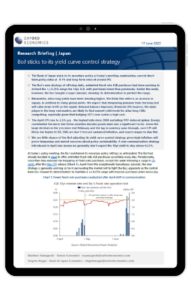BoJ sticks to its yield curve control strategy

The Bank of Japan stuck to its monetary policy at today’s (17 June) meeting, maintaining current short-term policy rates at -0.1% and long-term rates at around 0%.
The BoJ’s new strategy of offering daily, unlimited fixed-rate JGB purchases had been working to defend the +/-0.25% range for 10yr JGB, with purchases lower than previously. Earlier this week, however, the BoJ bought a larger amount, showing its determination to protect the range.
What you will learn:
- Meanwhile, ultra-long yields have been trending higher. We think this reflects an increase in supply, in addition to rising global yields. We expect that steepening pressure from the long end will calm down in H2 as the supply-demand balance improves.
- The April CPI rose to 2.5% y/y – the highest rate since 2008 excluding VAT-induced spikes. Given the large declines in the yen since end-February and the lag in currency pass-through, core-CPI will likely rise higher in H2. Still, we don’t forecast sustained inflation, and expect wages to stay flat.
- We see little chance of the BoJ adjusting its yield curve control strategy given high inflation will prove temporary and muted concerns about policy sustainability. A new communication strategy introduced in April also means we generally don’t expect the 10yr yield to stay above 0.25%.
Tags:
Related posts

Post
Tariffs and Politics Leave the BoJ Powerless in Japan
The Bank of Japan kept its policy rate at 0.5% at its July meeting. We continue to think the BoJ will exercise caution on rate hikes despite still-high inflation and a recent trade deal with the US.
Find Out More
Post
US-Japan Trade Deal Fails to Shift Japan’s Growth Outlook
We estimate that the US's effective tariff rate on Japanese products is around 17%, in line with our baseline assumption. Lower tariffs on autos are a positive, given the sector's significant contribution to the economy and its broad domestic supporting base
Find Out More
Post
Japan’s Rising Political Instability Will Undermine Fiscal Discipline
The ruling Liberal Democratic party (LDP) and its partner Komeito lost their majority in Japan's upper house elections on July 20. Although Prime Minister Shigeru Ishiba will likely stay to avoid political gridlock, especially to complete tariff negotiations with the US, the political situation has become fluid and could lead to a leadership change or the reshuffling of the coalition.
Find Out More